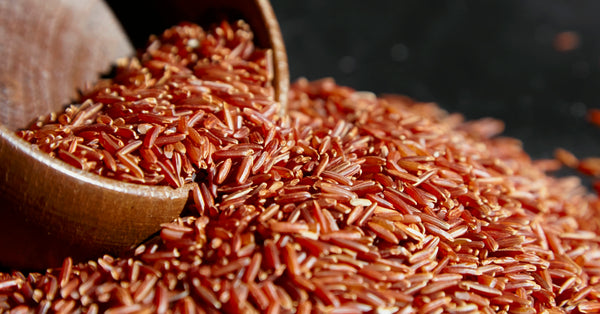Brown vs. Red vs. Black Rice: Which is the best for your family?

Rice is no stranger to any Filipino household. It’s our essential carbohydrate that fuels the body and helps us accomplish our daily activities.
While most Filipinos stick to plain white rice, there are several better options that differ in various aspects such as thickness, stickiness, color, flavor, and nutrition. Some are better for diets, some for strengthening against certain diseases, but each one has its own benefits that make it worth considering.
All these differences may make it quite difficult to choose which one really is the best for your family. In this guide, we’ll break down the differences of the most popular rice varieties and answer this question once and for all.
White Rice
The staple for most households -- it’s the simplest and cheapest choice, and the least nutritious among the options. White rice is milled, polished, and stripped off its husk, bran, and germ to help extend its shelf life. However, this refining process also removes most of its nutrients, resulting in less iron, fiber, vitamins, magnesium, and protein, among others.
Being lower in protein and fiber which slows down the absorption of sugars into the bloodstream, white rice is less filling and has a higher glycemic index than the other options. It is also much lower in antioxidants than its brown, red, and black counterparts.
In summary, white rice isn’t quite the best choice in any aspect besides its price. Now let’s take a look at its closest alternative: brown rice.

Brown Rice
Brown rice is a whole grain rice that is minimally processed to preserve its natural nutrients. Although its outer protective shell known as the hull is removed, the bran layer and germ are both preserved because they contain beneficial nutrients.
Protein, calcium, magnesium and potassium are some of the nutrients that can be found in brown rice. It also contains many flavonoid antioxidants, which have been linked to lower risks of chronic conditions such as cancer and heart disease. Brown rice also helps regulate blood sugar and insulin, making it a better choice for those with diabetes.
The amount of calories and carbohydrates found in brown rice is actually almost the same as the amount found in white rice, which means that it’s not an effective switch if you’re just looking to lower your calories. The advantage of brown rice in terms of diet is that it contains three times more fiber than white rice, which promotes feelings of fullness, helping you maintain a healthy weight.

Red Rice
A superior variety of rice in terms of its nutritional benefits; this includes Himalayan red rice, Thai red cargo rice, and Bhutanese red rice, among others.
Red rice is loved by fitness and health gurus due to its high fiber content, causing you to feel fuller for much longer durations and decreasing your desire to eat more. With this, your digestion is slowed down, and weight control becomes much easier to manage. Red rice is also completely fat-free, making it an effective way to drop a few unwanted pounds.
While its higher fiber and protein levels are amazing, its antioxidative properties are the real reason it shines. Red rice gets its rich color from anthocyanins. Besides pigmentation however, anthocyanins also provide strong antioxidant and anti-carcinogenic properties, aiding in heart disease, high cholesterol, cancer prevention, and diabetes.
In studies comparing different rice varieties, red rice has actually shown the best health results due to its extremely high antioxidant levels. It’s shown more potential to fight free radicals and contains even richer concentrations of flavonoid antioxidants than brown rice. To put this into perspective, red rice actually has 10x the antioxidants found in brown rice.

Black Rice
Black rice (which often turns purple when cooked) has several varieties such as Thai jasmine black rice and Indonesian black rice. It’s also been referred to as forbidden rice, said to have been reserved for royalty in ancient China.
The premium that was placed on this variety isn’t surprising due to its extremely high nutritional contents. Just like red rice, it gets its color from anthocyanins. To compare however, research has shown that black rice has the highest antioxidant activity among all the other varieties. With this, it contains similar benefits such as helping against heart disease, certain cancers, and other chronic conditions.
Again like red rice, it has also shown to be a great source of fiber, which promotes weight loss by increasing feelings of fullness. The anthocyanins found in black rice has also shown to aid in reducing body weight and body fat percentage.
Further, it has also shown to have benefits for eye health, as it contains lutein and zeaxanthin - carotenoids that help protect the retina by filtering out blue light waves. To add to those nutritional benefits, black rice is also the rice variety that’s richest in protein, and is a great source of iron.
Which should I choose?
Given all of this information, the confusion on which variety really is the best is quite a hard question. To give a slightly concrete answer - brown rice is better than white rice in many ways, but red and black rice take the spotlight with increased nutrients and effects on health.
So, red or black rice? Even for most researchers, each variety contains too many different nutrients to simply choose which is the best, or even to go over every single nutrient present. Based off each variety’s highlights though, red rice seems to be the choice for weight-loss and balanced diets aimed to get in better shape, whereas black rice has additional health benefits to top it off.
In the end, it’s really up to you, your preferences, and which among the different benefits are most important to you. Switching to any of these varieties from white rice definitely won’t hurt, so the best place to start is to try it out and see from there!
References:
https://www.huffpost.com/entry/make-the-switch-why-brown_b_8304558
https://www.healthline.com/nutrition/healthiest-rice#healthy-varieties
https://www.healthbenefitstimes.com/health-benefits-of-red-rice/
https://www.healthline.com/nutrition/black-rice-benefits#The-bottom-line




